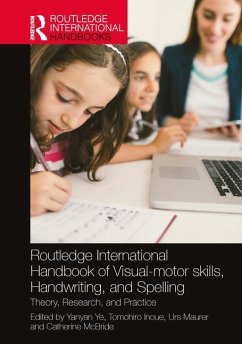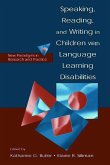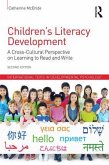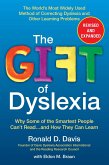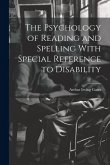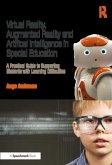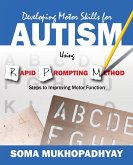Routledge International Handbook of Visual-Motor Skills, Handwriting, and Spelling
Theory, Research, and Practice
Herausgeber: Ye, Yanyan; Mcbride, Catherine; Maurer, Urs; Inoue, Tomohiro
Routledge International Handbook of Visual-Motor Skills, Handwriting, and Spelling
Theory, Research, and Practice
Herausgeber: Ye, Yanyan; Mcbride, Catherine; Maurer, Urs; Inoue, Tomohiro
- Broschiertes Buch
- Merkliste
- Auf die Merkliste
- Bewerten Bewerten
- Teilen
- Produkt teilen
- Produkterinnerung
- Produkterinnerung
This volume explores the potentially controversial field of early literacy education. It aims to offer scholars and practitioners an analysis of how and why handwriting skills benefit early literacy learning, especially spelling acquisition, and how this can enrich experiences for children and educators.
Andere Kunden interessierten sich auch für
![Speaking, Reading, and Writing in Children With Language Learning Disabilities Speaking, Reading, and Writing in Children With Language Learning Disabilities]() Speaking, Reading, and Writing in Children With Language Learning Disabilities73,99 €
Speaking, Reading, and Writing in Children With Language Learning Disabilities73,99 €![Children's Literacy Development Children's Literacy Development]() Catherine McbrideChildren's Literacy Development75,99 €
Catherine McbrideChildren's Literacy Development75,99 €![The Gift of Dyslexia The Gift of Dyslexia]() Ronald D DavisThe Gift of Dyslexia15,99 €
Ronald D DavisThe Gift of Dyslexia15,99 €![The Psychology of Reading and Spelling With Special Reference to Disability The Psychology of Reading and Spelling With Special Reference to Disability]() Arthur Irving GatesThe Psychology of Reading and Spelling With Special Reference to Disability18,99 €
Arthur Irving GatesThe Psychology of Reading and Spelling With Special Reference to Disability18,99 €![ADHD Homework Challenges Transformed ADHD Homework Challenges Transformed]() Harriet Hope GreenADHD Homework Challenges Transformed16,99 €
Harriet Hope GreenADHD Homework Challenges Transformed16,99 €![Virtual Reality, Augmented Reality and Artificial Intelligence in Special Education Virtual Reality, Augmented Reality and Artificial Intelligence in Special Education]() Ange AndersonVirtual Reality, Augmented Reality and Artificial Intelligence in Special Education45,99 €
Ange AndersonVirtual Reality, Augmented Reality and Artificial Intelligence in Special Education45,99 €![Developing Motor Skills for Autism Using Rapid Prompting Method Developing Motor Skills for Autism Using Rapid Prompting Method]() Soma MukhopadhyayDeveloping Motor Skills for Autism Using Rapid Prompting Method41,99 €
Soma MukhopadhyayDeveloping Motor Skills for Autism Using Rapid Prompting Method41,99 €-
-
-
This volume explores the potentially controversial field of early literacy education. It aims to offer scholars and practitioners an analysis of how and why handwriting skills benefit early literacy learning, especially spelling acquisition, and how this can enrich experiences for children and educators.
Produktdetails
- Produktdetails
- Verlag: Taylor & Francis
- Seitenzahl: 476
- Erscheinungstermin: 29. November 2024
- Englisch
- Abmessung: 246mm x 174mm x 25mm
- Gewicht: 789g
- ISBN-13: 9781032255767
- ISBN-10: 1032255765
- Artikelnr.: 70147297
- Herstellerkennzeichnung
- Libri GmbH
- Europaallee 1
- 36244 Bad Hersfeld
- gpsr@libri.de
- Verlag: Taylor & Francis
- Seitenzahl: 476
- Erscheinungstermin: 29. November 2024
- Englisch
- Abmessung: 246mm x 174mm x 25mm
- Gewicht: 789g
- ISBN-13: 9781032255767
- ISBN-10: 1032255765
- Artikelnr.: 70147297
- Herstellerkennzeichnung
- Libri GmbH
- Europaallee 1
- 36244 Bad Hersfeld
- gpsr@libri.de
Yanyan Ye, Assistant Professor, School of Applied Psychology, Beijing Normal University at Zhuhai. Tomohiro Inoue, Assistant Professor, Department of Psychology, The Chinese University of Hong Kong. Urs Maurer, Associate Professor, Department of Psychology, The Chinese University of Hong Kong. Catherine McBride, Professor, Department of Human Development and Family Science, Purdue University.
Introduction: Handbook of Visual-motor skills, Handwriting, and Spelling:
Theory, Research, and Practice
Yanyan Ye, Tomohiro Inoue, Urs Maurer, and Catherine McBride
Section I: The fundamentals of handwriting skills and literacy acquisition
Chapter 1: Visual-Motor Skill and General Cognitive Ability
Sebastian Paul Suggate
Chapter 2: Chinese character handwriting: Lexical effects, individual
differences, character amnesia, and developmental dysgraphia
Zebo Xu and Zhenguang G. Cai
Chapter 3: Visual motor integration and writing development: A systematic
review
of empirical research in Chinese
Rui Dong and Li Yin\
Chapter 4: It's About the Process, Not Perfection: What Spelling Fluency
Tells Us About Spelling
Emily Côté, Helen L. Breadmore, and S. Hélène Deacon
Chapter 5: Handwriting and Motor Skill Learning
Rafat Ghanamah, Mona S. Julius, and Esther Adi-Japha
Chapter 6: Conceptualizing and operationalizing Chinese early writing
skills: Integrate cognitive and sociocultural perspectives
Chenyi Zhang, Xiao Zhang, Gary E. Bingham
Section II: Cognitive and neural mechanisms of handwriting skills and
literacy acquisition
Chapter 7: The contribution of handwriting to letter processing in early
reading development: evidence from behavioral and neuroimaging research
Sophia Vinci-Booher and Karin H. James
Chapter 8: How handwriting shapes literacy acquisition and general
cognition: Phenomena and cognitive mechanisms
Markus Kiefer and Manfred Spitzer
Chapter 9: Does orthographic working memory matter in Chinese spelling?
Jianhong Mo
Chapter 10: Intrinsic and Extrinsic Factors of Handwriting and Their
Impacts on Reading: A View from Embodied Cognition
Zhengye Xu and Duo Liu
Section III: Theories and methods in spelling development
Chapter 11: Three Facets of Spelling
Jayde E. Homer, Molly Farry-Thorn, and Rebecca Treiman
Chapter 12: Understanding Types of Chinese Writing-to-Dictation Errors
Bing Han, Trelani F. Milburn, Poh Wee Koh, and R. Malatesha Joshi
Chapter 13: Credibly Assessing Writing Transcription Skills: Application of
Generalizability Theory
Steve Graham, Alan Huebner, and Gustaf B. Skar,
Chapter 14: The Role of Children's Learning about Print in the Development
of Reading and Spelling Skills
Savannah Heintzman, S. Hélène Deacon, and Nicole J. Conrad
Chapter 15: Invented Spelling: Perspectives on Assessment and Intervention
Yi Ding and Yangqian Shen
Chapter 16: The Role Played by Spelling in Reading Acquisition and
Instruction: Starring, Supporting, or Just a Bit Part?
Gene Ouellette
Chapter 17: Conceptual Understanding, Assessment, and Instruction for Word
Spelling in English, a Morphophonemic Orthography
Virginia Wise Berninger
Chapter 18: Creating a Team Approach to Handwriting Instruction: How
Collaboration Between the School-Based Occupational Therapist and Primary
Teacher Can Facilitate Literacy Development
Kathleen S. Wright and Carol H. Armann
Section IV: Global literacy and spelling
Chapter 19: Spelling in Some Alphabetic Languages
Alida Hudson, Karol A. Moore, Juan Quinonez-Beltran, Jialin Lai, and R. M.
Joshi
Chapter 20: Spelling Arabic: When does Orthographic Knowledge End and
Language Knowledge Start?
Elinor Saiegh-Haddad,Ola Ghawi-Dakwar, Lina Haj, Ranya Farraj-Bsharat, and
Lior Laks
Chapter 21: Early invented spelling predicts later word-reading ability
beyond early phoneme awareness and word-reading ability: Evidence from
Brazilian Portuguese
Cláudia Cardoso-Martins, Tatiana Pollo, Alana Helena Paulino dos Santos,
and Carolyn B. Mervis
Chapter 22: Spelling and Writing Development in Thai
Heather Winskel
Chapter 23: Immediate and Delayed Copying of Familiar and Unfamiliar
Scripts
in Spelling among Korean Kindergartners
Jeung-Ryeul Cho
Chapter 24: Emergent biliteracy: Spelling development across writing
systems and scripts
Beth Ann O'Brien and Malikka Begum Habib Mohamed
Section V: Home learning environment and spelling
Chapter 25: Parents' beliefs regarding their children's early literacy
surrounding a writing interaction and their relations to children's early
literacy skills
Dorit Aram and Deborah Bergman Deitcher
Chapter 26: Children's early spelling development in the context of the
home literacy environment
Frank Niklas, Astrid Wirth, Anna Mues, and Efsun Birtwistle
Section VI: Dysgraphia, Handwriting difficulties, and Dyslexia
Chapter 27: Handwriting Difficulties in Developmental Dyslexia
Marie Van Reybroeck and Claire Gosse
Chapter 28: Taking the mask off dysgraphia
Cheri Dotterer
Chapter 29: Handwriting Analytics
Burget, L., Wang C., Asselborn, T., Tozadore, D., Johal, W., Gargot, T.,
Sandygulova, A.,
Kidzinski, L., D, Cohen, D., and Dillenbourg, P.
Section VII: Spelling and writing in the digital age
Chapter 30: Chinese spelling - evidence from pen tablets
Dustin Kai-Yan Lau
Chapter 31: Digital communication, texting, and literacy acquisition
Nenagh Kemp
Theory, Research, and Practice
Yanyan Ye, Tomohiro Inoue, Urs Maurer, and Catherine McBride
Section I: The fundamentals of handwriting skills and literacy acquisition
Chapter 1: Visual-Motor Skill and General Cognitive Ability
Sebastian Paul Suggate
Chapter 2: Chinese character handwriting: Lexical effects, individual
differences, character amnesia, and developmental dysgraphia
Zebo Xu and Zhenguang G. Cai
Chapter 3: Visual motor integration and writing development: A systematic
review
of empirical research in Chinese
Rui Dong and Li Yin\
Chapter 4: It's About the Process, Not Perfection: What Spelling Fluency
Tells Us About Spelling
Emily Côté, Helen L. Breadmore, and S. Hélène Deacon
Chapter 5: Handwriting and Motor Skill Learning
Rafat Ghanamah, Mona S. Julius, and Esther Adi-Japha
Chapter 6: Conceptualizing and operationalizing Chinese early writing
skills: Integrate cognitive and sociocultural perspectives
Chenyi Zhang, Xiao Zhang, Gary E. Bingham
Section II: Cognitive and neural mechanisms of handwriting skills and
literacy acquisition
Chapter 7: The contribution of handwriting to letter processing in early
reading development: evidence from behavioral and neuroimaging research
Sophia Vinci-Booher and Karin H. James
Chapter 8: How handwriting shapes literacy acquisition and general
cognition: Phenomena and cognitive mechanisms
Markus Kiefer and Manfred Spitzer
Chapter 9: Does orthographic working memory matter in Chinese spelling?
Jianhong Mo
Chapter 10: Intrinsic and Extrinsic Factors of Handwriting and Their
Impacts on Reading: A View from Embodied Cognition
Zhengye Xu and Duo Liu
Section III: Theories and methods in spelling development
Chapter 11: Three Facets of Spelling
Jayde E. Homer, Molly Farry-Thorn, and Rebecca Treiman
Chapter 12: Understanding Types of Chinese Writing-to-Dictation Errors
Bing Han, Trelani F. Milburn, Poh Wee Koh, and R. Malatesha Joshi
Chapter 13: Credibly Assessing Writing Transcription Skills: Application of
Generalizability Theory
Steve Graham, Alan Huebner, and Gustaf B. Skar,
Chapter 14: The Role of Children's Learning about Print in the Development
of Reading and Spelling Skills
Savannah Heintzman, S. Hélène Deacon, and Nicole J. Conrad
Chapter 15: Invented Spelling: Perspectives on Assessment and Intervention
Yi Ding and Yangqian Shen
Chapter 16: The Role Played by Spelling in Reading Acquisition and
Instruction: Starring, Supporting, or Just a Bit Part?
Gene Ouellette
Chapter 17: Conceptual Understanding, Assessment, and Instruction for Word
Spelling in English, a Morphophonemic Orthography
Virginia Wise Berninger
Chapter 18: Creating a Team Approach to Handwriting Instruction: How
Collaboration Between the School-Based Occupational Therapist and Primary
Teacher Can Facilitate Literacy Development
Kathleen S. Wright and Carol H. Armann
Section IV: Global literacy and spelling
Chapter 19: Spelling in Some Alphabetic Languages
Alida Hudson, Karol A. Moore, Juan Quinonez-Beltran, Jialin Lai, and R. M.
Joshi
Chapter 20: Spelling Arabic: When does Orthographic Knowledge End and
Language Knowledge Start?
Elinor Saiegh-Haddad,Ola Ghawi-Dakwar, Lina Haj, Ranya Farraj-Bsharat, and
Lior Laks
Chapter 21: Early invented spelling predicts later word-reading ability
beyond early phoneme awareness and word-reading ability: Evidence from
Brazilian Portuguese
Cláudia Cardoso-Martins, Tatiana Pollo, Alana Helena Paulino dos Santos,
and Carolyn B. Mervis
Chapter 22: Spelling and Writing Development in Thai
Heather Winskel
Chapter 23: Immediate and Delayed Copying of Familiar and Unfamiliar
Scripts
in Spelling among Korean Kindergartners
Jeung-Ryeul Cho
Chapter 24: Emergent biliteracy: Spelling development across writing
systems and scripts
Beth Ann O'Brien and Malikka Begum Habib Mohamed
Section V: Home learning environment and spelling
Chapter 25: Parents' beliefs regarding their children's early literacy
surrounding a writing interaction and their relations to children's early
literacy skills
Dorit Aram and Deborah Bergman Deitcher
Chapter 26: Children's early spelling development in the context of the
home literacy environment
Frank Niklas, Astrid Wirth, Anna Mues, and Efsun Birtwistle
Section VI: Dysgraphia, Handwriting difficulties, and Dyslexia
Chapter 27: Handwriting Difficulties in Developmental Dyslexia
Marie Van Reybroeck and Claire Gosse
Chapter 28: Taking the mask off dysgraphia
Cheri Dotterer
Chapter 29: Handwriting Analytics
Burget, L., Wang C., Asselborn, T., Tozadore, D., Johal, W., Gargot, T.,
Sandygulova, A.,
Kidzinski, L., D, Cohen, D., and Dillenbourg, P.
Section VII: Spelling and writing in the digital age
Chapter 30: Chinese spelling - evidence from pen tablets
Dustin Kai-Yan Lau
Chapter 31: Digital communication, texting, and literacy acquisition
Nenagh Kemp
Introduction: Handbook of Visual-motor skills, Handwriting, and Spelling:
Theory, Research, and Practice
Yanyan Ye, Tomohiro Inoue, Urs Maurer, and Catherine McBride
Section I: The fundamentals of handwriting skills and literacy acquisition
Chapter 1: Visual-Motor Skill and General Cognitive Ability
Sebastian Paul Suggate
Chapter 2: Chinese character handwriting: Lexical effects, individual
differences, character amnesia, and developmental dysgraphia
Zebo Xu and Zhenguang G. Cai
Chapter 3: Visual motor integration and writing development: A systematic
review
of empirical research in Chinese
Rui Dong and Li Yin\
Chapter 4: It's About the Process, Not Perfection: What Spelling Fluency
Tells Us About Spelling
Emily Côté, Helen L. Breadmore, and S. Hélène Deacon
Chapter 5: Handwriting and Motor Skill Learning
Rafat Ghanamah, Mona S. Julius, and Esther Adi-Japha
Chapter 6: Conceptualizing and operationalizing Chinese early writing
skills: Integrate cognitive and sociocultural perspectives
Chenyi Zhang, Xiao Zhang, Gary E. Bingham
Section II: Cognitive and neural mechanisms of handwriting skills and
literacy acquisition
Chapter 7: The contribution of handwriting to letter processing in early
reading development: evidence from behavioral and neuroimaging research
Sophia Vinci-Booher and Karin H. James
Chapter 8: How handwriting shapes literacy acquisition and general
cognition: Phenomena and cognitive mechanisms
Markus Kiefer and Manfred Spitzer
Chapter 9: Does orthographic working memory matter in Chinese spelling?
Jianhong Mo
Chapter 10: Intrinsic and Extrinsic Factors of Handwriting and Their
Impacts on Reading: A View from Embodied Cognition
Zhengye Xu and Duo Liu
Section III: Theories and methods in spelling development
Chapter 11: Three Facets of Spelling
Jayde E. Homer, Molly Farry-Thorn, and Rebecca Treiman
Chapter 12: Understanding Types of Chinese Writing-to-Dictation Errors
Bing Han, Trelani F. Milburn, Poh Wee Koh, and R. Malatesha Joshi
Chapter 13: Credibly Assessing Writing Transcription Skills: Application of
Generalizability Theory
Steve Graham, Alan Huebner, and Gustaf B. Skar,
Chapter 14: The Role of Children's Learning about Print in the Development
of Reading and Spelling Skills
Savannah Heintzman, S. Hélène Deacon, and Nicole J. Conrad
Chapter 15: Invented Spelling: Perspectives on Assessment and Intervention
Yi Ding and Yangqian Shen
Chapter 16: The Role Played by Spelling in Reading Acquisition and
Instruction: Starring, Supporting, or Just a Bit Part?
Gene Ouellette
Chapter 17: Conceptual Understanding, Assessment, and Instruction for Word
Spelling in English, a Morphophonemic Orthography
Virginia Wise Berninger
Chapter 18: Creating a Team Approach to Handwriting Instruction: How
Collaboration Between the School-Based Occupational Therapist and Primary
Teacher Can Facilitate Literacy Development
Kathleen S. Wright and Carol H. Armann
Section IV: Global literacy and spelling
Chapter 19: Spelling in Some Alphabetic Languages
Alida Hudson, Karol A. Moore, Juan Quinonez-Beltran, Jialin Lai, and R. M.
Joshi
Chapter 20: Spelling Arabic: When does Orthographic Knowledge End and
Language Knowledge Start?
Elinor Saiegh-Haddad,Ola Ghawi-Dakwar, Lina Haj, Ranya Farraj-Bsharat, and
Lior Laks
Chapter 21: Early invented spelling predicts later word-reading ability
beyond early phoneme awareness and word-reading ability: Evidence from
Brazilian Portuguese
Cláudia Cardoso-Martins, Tatiana Pollo, Alana Helena Paulino dos Santos,
and Carolyn B. Mervis
Chapter 22: Spelling and Writing Development in Thai
Heather Winskel
Chapter 23: Immediate and Delayed Copying of Familiar and Unfamiliar
Scripts
in Spelling among Korean Kindergartners
Jeung-Ryeul Cho
Chapter 24: Emergent biliteracy: Spelling development across writing
systems and scripts
Beth Ann O'Brien and Malikka Begum Habib Mohamed
Section V: Home learning environment and spelling
Chapter 25: Parents' beliefs regarding their children's early literacy
surrounding a writing interaction and their relations to children's early
literacy skills
Dorit Aram and Deborah Bergman Deitcher
Chapter 26: Children's early spelling development in the context of the
home literacy environment
Frank Niklas, Astrid Wirth, Anna Mues, and Efsun Birtwistle
Section VI: Dysgraphia, Handwriting difficulties, and Dyslexia
Chapter 27: Handwriting Difficulties in Developmental Dyslexia
Marie Van Reybroeck and Claire Gosse
Chapter 28: Taking the mask off dysgraphia
Cheri Dotterer
Chapter 29: Handwriting Analytics
Burget, L., Wang C., Asselborn, T., Tozadore, D., Johal, W., Gargot, T.,
Sandygulova, A.,
Kidzinski, L., D, Cohen, D., and Dillenbourg, P.
Section VII: Spelling and writing in the digital age
Chapter 30: Chinese spelling - evidence from pen tablets
Dustin Kai-Yan Lau
Chapter 31: Digital communication, texting, and literacy acquisition
Nenagh Kemp
Theory, Research, and Practice
Yanyan Ye, Tomohiro Inoue, Urs Maurer, and Catherine McBride
Section I: The fundamentals of handwriting skills and literacy acquisition
Chapter 1: Visual-Motor Skill and General Cognitive Ability
Sebastian Paul Suggate
Chapter 2: Chinese character handwriting: Lexical effects, individual
differences, character amnesia, and developmental dysgraphia
Zebo Xu and Zhenguang G. Cai
Chapter 3: Visual motor integration and writing development: A systematic
review
of empirical research in Chinese
Rui Dong and Li Yin\
Chapter 4: It's About the Process, Not Perfection: What Spelling Fluency
Tells Us About Spelling
Emily Côté, Helen L. Breadmore, and S. Hélène Deacon
Chapter 5: Handwriting and Motor Skill Learning
Rafat Ghanamah, Mona S. Julius, and Esther Adi-Japha
Chapter 6: Conceptualizing and operationalizing Chinese early writing
skills: Integrate cognitive and sociocultural perspectives
Chenyi Zhang, Xiao Zhang, Gary E. Bingham
Section II: Cognitive and neural mechanisms of handwriting skills and
literacy acquisition
Chapter 7: The contribution of handwriting to letter processing in early
reading development: evidence from behavioral and neuroimaging research
Sophia Vinci-Booher and Karin H. James
Chapter 8: How handwriting shapes literacy acquisition and general
cognition: Phenomena and cognitive mechanisms
Markus Kiefer and Manfred Spitzer
Chapter 9: Does orthographic working memory matter in Chinese spelling?
Jianhong Mo
Chapter 10: Intrinsic and Extrinsic Factors of Handwriting and Their
Impacts on Reading: A View from Embodied Cognition
Zhengye Xu and Duo Liu
Section III: Theories and methods in spelling development
Chapter 11: Three Facets of Spelling
Jayde E. Homer, Molly Farry-Thorn, and Rebecca Treiman
Chapter 12: Understanding Types of Chinese Writing-to-Dictation Errors
Bing Han, Trelani F. Milburn, Poh Wee Koh, and R. Malatesha Joshi
Chapter 13: Credibly Assessing Writing Transcription Skills: Application of
Generalizability Theory
Steve Graham, Alan Huebner, and Gustaf B. Skar,
Chapter 14: The Role of Children's Learning about Print in the Development
of Reading and Spelling Skills
Savannah Heintzman, S. Hélène Deacon, and Nicole J. Conrad
Chapter 15: Invented Spelling: Perspectives on Assessment and Intervention
Yi Ding and Yangqian Shen
Chapter 16: The Role Played by Spelling in Reading Acquisition and
Instruction: Starring, Supporting, or Just a Bit Part?
Gene Ouellette
Chapter 17: Conceptual Understanding, Assessment, and Instruction for Word
Spelling in English, a Morphophonemic Orthography
Virginia Wise Berninger
Chapter 18: Creating a Team Approach to Handwriting Instruction: How
Collaboration Between the School-Based Occupational Therapist and Primary
Teacher Can Facilitate Literacy Development
Kathleen S. Wright and Carol H. Armann
Section IV: Global literacy and spelling
Chapter 19: Spelling in Some Alphabetic Languages
Alida Hudson, Karol A. Moore, Juan Quinonez-Beltran, Jialin Lai, and R. M.
Joshi
Chapter 20: Spelling Arabic: When does Orthographic Knowledge End and
Language Knowledge Start?
Elinor Saiegh-Haddad,Ola Ghawi-Dakwar, Lina Haj, Ranya Farraj-Bsharat, and
Lior Laks
Chapter 21: Early invented spelling predicts later word-reading ability
beyond early phoneme awareness and word-reading ability: Evidence from
Brazilian Portuguese
Cláudia Cardoso-Martins, Tatiana Pollo, Alana Helena Paulino dos Santos,
and Carolyn B. Mervis
Chapter 22: Spelling and Writing Development in Thai
Heather Winskel
Chapter 23: Immediate and Delayed Copying of Familiar and Unfamiliar
Scripts
in Spelling among Korean Kindergartners
Jeung-Ryeul Cho
Chapter 24: Emergent biliteracy: Spelling development across writing
systems and scripts
Beth Ann O'Brien and Malikka Begum Habib Mohamed
Section V: Home learning environment and spelling
Chapter 25: Parents' beliefs regarding their children's early literacy
surrounding a writing interaction and their relations to children's early
literacy skills
Dorit Aram and Deborah Bergman Deitcher
Chapter 26: Children's early spelling development in the context of the
home literacy environment
Frank Niklas, Astrid Wirth, Anna Mues, and Efsun Birtwistle
Section VI: Dysgraphia, Handwriting difficulties, and Dyslexia
Chapter 27: Handwriting Difficulties in Developmental Dyslexia
Marie Van Reybroeck and Claire Gosse
Chapter 28: Taking the mask off dysgraphia
Cheri Dotterer
Chapter 29: Handwriting Analytics
Burget, L., Wang C., Asselborn, T., Tozadore, D., Johal, W., Gargot, T.,
Sandygulova, A.,
Kidzinski, L., D, Cohen, D., and Dillenbourg, P.
Section VII: Spelling and writing in the digital age
Chapter 30: Chinese spelling - evidence from pen tablets
Dustin Kai-Yan Lau
Chapter 31: Digital communication, texting, and literacy acquisition
Nenagh Kemp

